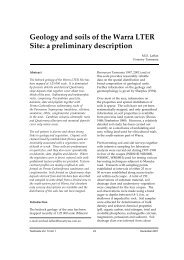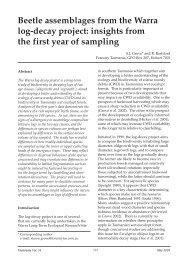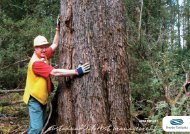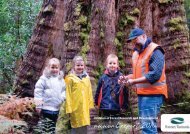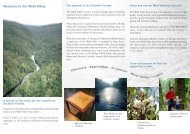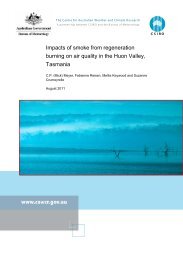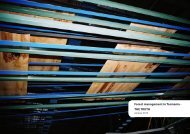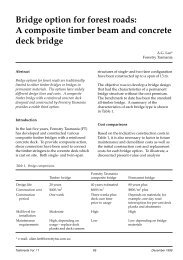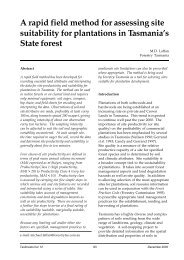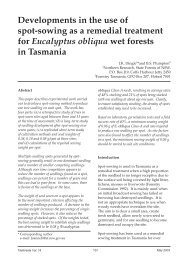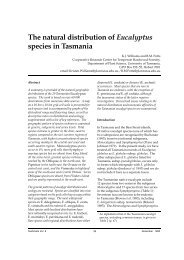Professor Ivan Tomaselli Report - Forestry Tasmania
Professor Ivan Tomaselli Report - Forestry Tasmania
Professor Ivan Tomaselli Report - Forestry Tasmania
Create successful ePaper yourself
Turn your PDF publications into a flip-book with our unique Google optimized e-Paper software.
Increased use of peninsulas would drive the silviculture system towards a similar condition<br />
as the stripfell treatment, but design of the peninsulas should be changed to improve<br />
aesthetic values. On the other hand peninsulas might create difficulties for harvesting<br />
operations (creating additional costs) and the risk for workers needs to be better assessed.<br />
It is important to have in mind that a few years more of field observations will be necessary<br />
to have scientific evidence of other potential benefits from VR silviculture for biodiversity,<br />
soil protection and seed supply for regeneration of the harvested areas. The perception of<br />
the consultant is that gains in biodiversity by using the new silvicultural system might be<br />
important when analyzing a micro location (retained areas within the coupe and for coarse<br />
woody debris left in the ground). However, given the size of the operations and the long<br />
forest rotations adopted, its differential contribution over time in terms of maintenance of<br />
the biodiversity of the <strong>Tasmania</strong> forests as a whole is most probably negligible.<br />
It might not desirable for <strong>Forestry</strong> <strong>Tasmania</strong> to enter into this discussion. The local gains in<br />
biodiversity of the new system, as compared with the traditional CBS system, can be<br />
important in dealing with public perception, and this is what needs to be explored by<br />
<strong>Forestry</strong> <strong>Tasmania</strong>. Also the variable retention system seems to be an adequate alternative<br />
to the traditional CBS silvicultural system when dealing with aesthetic values, which has a<br />
strong impact on public perception, and this is important to maintain <strong>Forestry</strong> <strong>Tasmania</strong>’s<br />
operations at the moment.<br />
4- MANAGEMENT OF REGROWTH FORESTS<br />
Regrowth forests are currently managed on relatively long rotations (80 – 100 years). Based<br />
on the discussions, the reasons for such long rotations are associated with economic and<br />
environment aspects, but no clear evidence to support these were made available.<br />
Longer rotations allow a forest area to be left undisturbed for a longer period, and this<br />
probably creates environment benefits. On the other hand longer rotations allow larger logs<br />
for the industry, and this is more a tradition in the local forest industry than a technical and<br />
economic matter.<br />
Observation made in regrowth forests recently thinned (with an approximate age of 40<br />
years) indicate that most of the logs could be used for sawnwood and veneer production<br />
using current available processing technology, and most probably would benefit the<br />
industry. Practically all logs used in the Southwood industrial complex (involving a<br />
sawmill and a veneer mill) are small to medium diameter logs that could be produced in<br />
rotations of 50 years (or less).<br />
<strong>Forestry</strong> <strong>Tasmania</strong> has probably already studied the economic implications of reducing the<br />
management rotation of regrowth forests, but it seems that for several reasons this option<br />
has not been fully explored. In principle, in economic terms, the reduction in rotation would<br />
be a first alternative to be explored to maintain wood output at current levels if harvesting<br />
in oldgrowth forests has to be reduced.<br />
9 9




